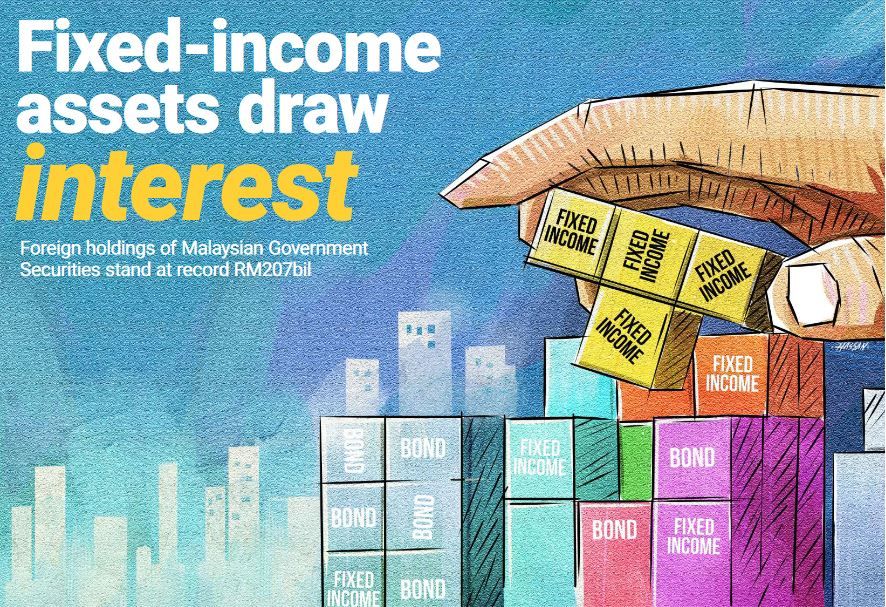
BIX ARTICLE
Fixed-Income Assets Draw Interest
Aug 21, 2023
|
6 min read
Featured Posts
Social Bonds Illustrative Use-Of-Proceeds Case Studies Coronavirus
Jul 06, 2020
|
2 min read
Sustainable Banking Network (SBN) Creating Green Bond Markets
Jul 06, 2020
|
2 min read
Why is Inflation Making a Big Comeback After Being Absent for Decades in the U.S.?
Mar 24, 2022
|
7 min read
SC issues Corporate Governance Strategic Priorities 2021-2023
Mar 29, 2022
|
3 min read

PETALING JAYA: Investors are flocking to fixed-income assets like bonds to preserve capital and income as well as ensure stability in their investments due to a challenging business climate.
According to fund managers, the recent mini-banking crisis, hawkish monetary policy and geopolitical tensions have diverted investor attention to fixed-income assets because of their consistency.
They said the asset class would help to preserve capital and income, and diversify investors’ portfolios.
Principal South-East Asia chief investment officer for fixed income Jesse Liew told StarBiz while the US economic growth and labour markets appeared to be faring better than expected in recent months, leading indicators are pointing to a bleak outlook in 2024.
The indicators include the ISM Manufacturing Index, NFIB Small Business Optimism Index and tightening in bank lending standards.
Judging from the ISM Manufacturing Index, economic activity in the US manufacturing sector contracted in June for the eighth consecutive month following a 28-month period of growth.
The NFIB Small Business Optimism Index in the United States increased 0.9 of a point in July to 91.9, marking the 19th consecutive month below the 49-year average of 98.
 Principal South-East Asia chief investment officer for fixed income Jesse Liew
Principal South-East Asia chief investment officer for fixed income Jesse LiewLiew said Malaysia is also seeing a downtrend in core inflation and weakening in its exports in recent months.
“This coupled with the downtrend in inflation data lead us to believe that monetary policy rates are close to their peaks for most central banks, including Bank Negara, which will make fixed-income assets appear appealing given that yields have adjusted higher over the last two years.
“Additionally, the demand for Malaysian fixed-income assets has been validated by the consecutive inflows by foreigners for seven straight months year-to-date in July 2023 amounting to RM32.4bil.
“Foreign holdings of Malaysian Government Securities (MGS) currently stand at an all-time high of RM207bil or 36.6% of total outstanding,” he noted.
Principal South-East Asia comes under the operations of Principal Asset Management Bhd (Principal Malaysia).
As at July 31, Principal Malaysia’s total value of assets under management stood at RM 66.67bil.
Principal Malaysia is a joint venture between US-based Principal Financial Group, a Nasdaq-listed global financial services company, and CIMB Group Holdings Bhd.
Meanwhile, RAM Ratings said foreign investors flocked to Malaysia last month, spurred by growing signs that the US Federal Reserve (Fed) is nearing the end of its rate tightening cycle.
The overall foreign inflow into the bond market more than doubled month-on-month to RM11.3bil (June: RM5.2bil) – the largest since June 2020 and the seventh successive month of foreign net purchases.
The better investor sentiment and appetite for riskier emerging market assets came on the heels of an encouraging US inflation print release in early July, which showed a moderation to 3% – the lowest since March 2021, the rating agency said.
As to whether the returns from fixed-income assets would outstrip equities and other asset classes, Liew said there has been a revival in the performance of equities.
However, he said, when compared to the Malaysian bond market, the latter has demonstrated a notably superior risk-return profile on a year-to-date basis as of July 2023, having achieved benchmark returns exceeding 5%.
He said it remains challenging to accurately time the market, especially in the context of transitioning between equities and fixed income.
“As the landscape of both politics and economics continues to evolve, investors can extract value from these unfolding events.
“That being said, it is imperative to strategically position a portfolio that not only capitalises on these anomalies but also safeguards it against unwarranted volatility.
“Our perspective aligns with the belief that fixed-income assets like bonds will continue to offer appealing risk-return attributes to an investor’s portfolio in the foreseeable future,” he added.
Delving into the prospects of fixed-income assets for this year, Liew said he is generally positive on the outlook as believes that monetary policy rates are close to their peaks for most central banks globally.
While Malaysia appears to be experiencing some softening in its overall external demand, the nation would not likely enter into a recession as its growth would likely be anchored by the still resilient domestic demand.
He said that on the whole, the demand for corporate bonds has been strong this year, as most corporations are well placed to withstand rising interest rates and a global slowdown due to relatively strong balance sheets.
Liew added: “While we do expect some margin erosion due to cost pressures, we think corporate defaults and downgrades will be well contained, compared to the previous two years.
“In fact, Principal is looking at more positive rating actions coming from rating agencies this year, as the uncertainties of the Covid-19 pandemic lockdown seem to be behind us and the reopening of the economy has helped to lift the business outlook of many corporations affected previously by the lockdowns.
“The stronger demand in corporate bonds has led to an overall tightening in credit spreads throughout 2023.”
On whether the Fed would likely raise interest rates one more time this year and divert investors to higher US treasury (UST) yields, hence causing outflows from the local bond market, Liew said this argument holds partially true as was observed in the foreign outflows in 2022 amounting to RM9.8bil amid the aggressive monetary tightening.
He said the interest rate differential between the two countries has also placed pressures on the ringgit as it weakened to a high of 4.75 in November 2022.
“Nevertheless, we would also point out that the overall interest rate environment and dynamics are different between the two countries.
“While the yields on the 10-year UST have spiked by 237 basis points (bps) from 1.51% to 3.88% in 2022, the demand for Malaysian bonds remained strong by domestic investors (i.e. the Employees Provident Fund and banks) and have limited the adjustments on the 10-year MGS as it moved higher by a smaller magnitude of 45 bps from 3.59% to 4.04% (as at end-July 2023).
“Furthermore, the adjustments experienced in the MGS market have been more muted vis-a-vis UST, as the pressures on inflation have been controlled by the government through the subsidies on oil and electricity tariffs as well as price control on food items,” Liew said.
Disclaimer
The information provided in this report is of a general nature and has been prepared for information purposes only. It is not intended to constitute research or as advice for any investor. The information in this report is not and should not be construed or considered as an offer, recommendation or solicitation for investments. Investors are advised to make their own independent evaluation of the information contained in this report, consider their own individual investment objectives, financial situation and particular needs and should seek appropriate personalised financial advice from a qualified professional to suit individual circumstances and risk profile.
The information contained in this report is prepared from data believed to be correct and reliable at the time of issuance of this report. While every effort is made to ensure the information is up-to-date and correct, Bond and Sukuk Information Platform Sdn Bhd (“the Company”) does not make any guarantee, representation or warranty, express or implied, as to the adequacy, accuracy, completeness, reliability or fairness of any such information contained in this report and accordingly, neither the Company nor any of its affiliates nor its related persons shall not be liable in any manner whatsoever for any consequences (including but not limited to any direct, indirect or consequential losses, loss of profits and damages) of any reliance thereon or usage thereof.
YOU MAY ALSO LIKE
ARTICLE
Dec 18, 2025
|
7 min read
ARTICLE
Dec 16, 2025
|
5 min read
ARTICLE
Dec 15, 2025
|
3 min read
ARTICLE
Dec 12, 2025
|
5 min read


